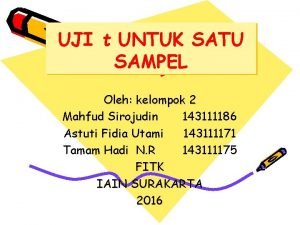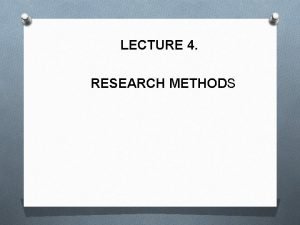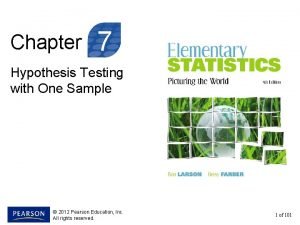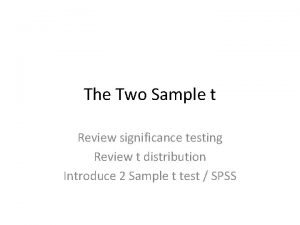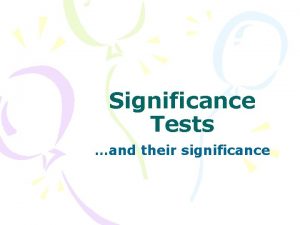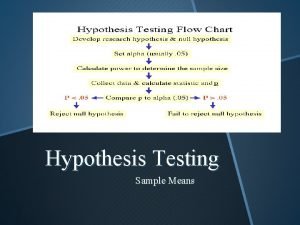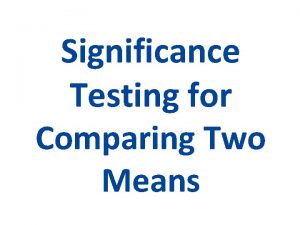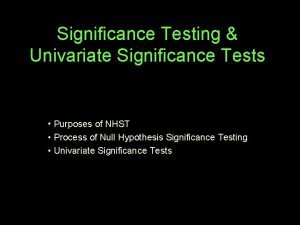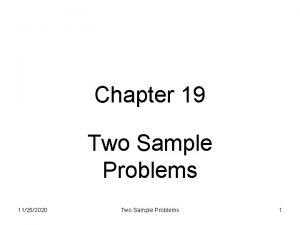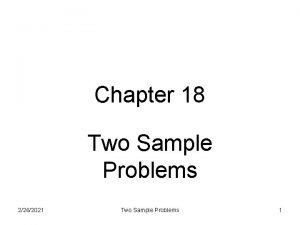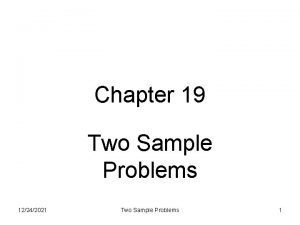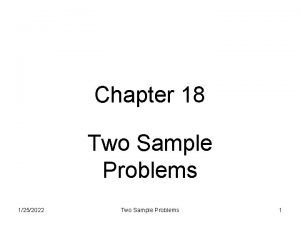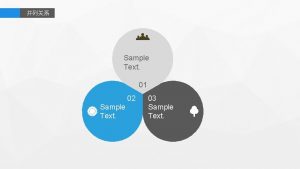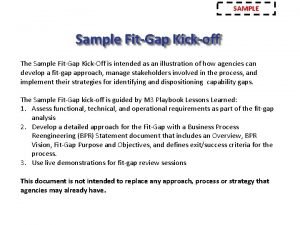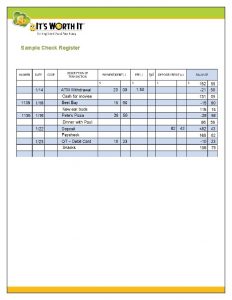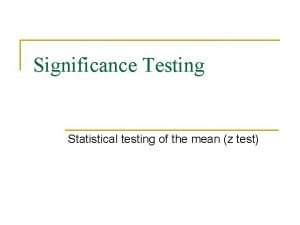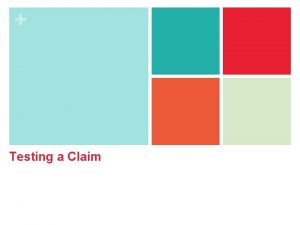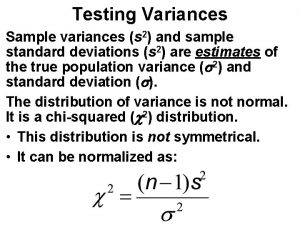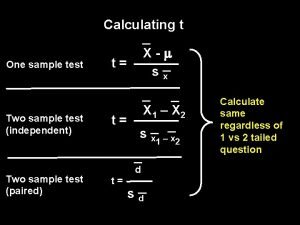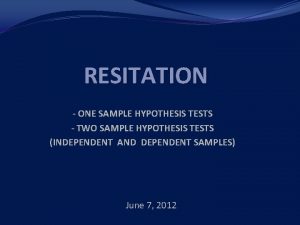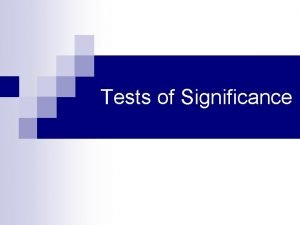The Two Sample t Review significance testing Review

























- Slides: 25

The Two Sample t Review significance testing Review t distribution Introduce 2 Sample t test / SPSS

Significance Testing • State a Null Hypothesis • Calculate the odds of obtaining your sample finding if the null hypothesis is correct – Compare this to the odds that you set ahead of time (e. g. , alpha) – If odds are less than alpha, reject the null in favor of the research hypothesis • The sample finding would be so rare if the null is true that it makes more sense to reject the null hypothesis

Significance the old fashioned way • Find the “critical value” of the test statistic for your sample outcome – Z tests always have the same critical values for given alpha values (e. g. , . 05 alpha +/- 1. 96) • Use if N >100 – t values change with sample size • Use if N < 100 • As N reaches 100, t and z values become almost identical • Compare the critical value with the obtained value Are the odds of this sample outcome less than 5% (or 1% if alpha =. 01)?

Critical Values/Region for the z test ( =. 05)

Directionality • Research hypothesis must be directional – Predict how the IV will relate to the DV • Males are more likely than females to… • Southern states should have lower scores…

Non-Directional & Directional Hypotheses • Nondirectional – Ho: there is no effect: (X = µ) – H 1: there IS an effect: (X ≠ µ) – APPLY 2 -TAILED TEST • 2. 5% chance of error in each tail -1. 96 • Directional – H 1: sample mean is larger than population mean (X > µ) – Ho x ≤ µ – APPLY 1 -TAILED TEST • 5% chance of error in one tail 1. 65

STUDENT’S t DISTRIBUTION – Find the t (critical) values in App. B of Healey – “degrees of freedom” • # of values in a distribution that are free to vary • Here, df = N-1 Practice: ALPHA. 05. 01. 10. 05 TEST 2 -tailed 1 -tailed N 57 25 32 15 t(Critical)

Example: Single sample means, smaller N 1. A random sample of 16 UMD students completed an IQ test. They scored an average of 104, with a standard deviation of 9. The IQ test has a national average of 100. IS the UMD students average different form the national average? 2. Professor Fred hypothesizes that Duluthians are more polite than the average American. A random sample of 50 Duluth residents yields an average score on the Fred politeness scale (FPS) of 31 (s = 9). The national average is known to be 29. Write the research an null hypotheses. What can you conclude? • USE ALPHA =. 05 for both

Answer #1 Conceptually • Under the null hypothesis (no difference between means), there is more than a 5% chance of obtaining a mean difference this large. t (obtained) = 1. 72 Critical Region Sampling distribution for one sample t-test (a hypothetical plot of an infinite number of mean differences, assuming null was correct) Critical Region -2. 131 (t-crit, df=15)

“ 2 -Sample” t test – Apply when… • You have a hypothesis that the means (or proportions) of a variable differ between 2 populations – Components – 2 representative samples – Don’t get confused here (usually both come from same “sample”) – One interval/ratio dependent variable – Examples » Do male and female differ in their aggression (# aggressive acts in past week)? » Is there a difference between MN & WI in the proportion who eat cheese every day? – Null Hypothesis (Ho) • The 2 pops. are not different in terms of the dependent variable

2 -SAMPLE HYPOTHESIS TESTING • Assumptions: – Random (probability) sampling – Groups are independent – Homogeneity of variance » the amount of variability in the D. V. is about equal in each of the 2 groups – The sampling distribution of the difference between means is normal in shape

2 -SAMPLE HYPOTHESIS TESTING • We rarely know population S. D. s – Therefore, for 2 -sample t-testing, we must use 2 sample S. D. s, corrected for bias: » “Pooled Estimate” • Focus on the t statistic: t (obtained) = (X – X) σ x-x • we’re finding the difference between the two means… …and standardizing this difference with the pooled estimate

2 -SAMPLE HYPOTHESIS TESTING 2 -Sample Sampling Distribution – difference between sample means (closer sample means will have differences closer to 0) • t-test for the difference between 2 sample means: • Does our observed difference between the sample means reflects a real difference in the population means or is due to sampling error? - t critical ASSUMING THE NULL! 0 t critical

Applying the 2 -Sample t Formula – Example: • Research Hypothesis (H 1): – Soc. majors at UMD drink more beers per month than non-soc. majors – Random sample of 205 students: » Soc majors: N = 100, mean=16, s=2. 0 » Non soc. majors: N = 105, mean=15, s=2. 5 » Alpha =. 01 » FORMULA: t(obtained) = X 1 – X 2 pooled estimate

Answers • Null Hypothesis (Ho): Soc. majors at UMD DO NOT drink more beers per month than non-soc. Majors • Directional 1 tailed test • tcritical for 1 tailed test with 203 df and =. 05 (use infinity) = 1. 645 • tobtained = 3. 13 – Reject null hypothesis: there is less than a 1% chance of obtaining a mean difference of 1 beer if the null hypothesis is true. • 3. 13 standard errors separates soc and non-soc majors with respect to their average beer consumption

Example 2 • Dr. Phil believes that inmates with tattoos will get in more fights than inmates without tattoos. • Tattooed inmates N = 25, s = 1. 06, mean = 1. 00 • Non-Tattooed inmates N = 37, s =. 5599, mean = 0. 5278 – Null hypothesis? – Directional or non? – tcritical? – Difference between means? – Significant at the. 01 level?

Answers • Null hypothesis: – Inmates with tattoos will NOT get in more fights than inmates without tattoos. • Use a 1 or 2 -tailed test? – One-tailed test because theory predicts that inmates with tattoos will get into MORE fights. • tcritical (60 df) = 2. 390 • tobtained = 2. 23

Answers • Reject the null? – No, because the t(obtained) (2. 23) is less than the t(critical, one-tail, df=398) (1. 658) • This t value indicates there are 2. 23 standard error units that separate the two mean values – Greater than a 1% chance of getting this finding under null • SPSS DEMO

2 -Sample Hypothesis Testing in SPSS • Independent Samples t Test Output: – Testing the Ho that there is no difference in number of adult arrests between a sample of individuals who were abused/neglected as children and a matched control group.

Interpreting SPSS Output • Difference in mean # of adult arrests between those who were abused as children & control group

Interpreting SPSS Output • t statistic, with degrees of freedom

Interpreting SPSS Output • “Sig. (2 tailed)” – gives the actual probability of obtaining this finding if the null is correct • a. k. a. the “p value” – p = probability • The odds are NOT ZERO (if you get. ooo, interpret as <. 001)

“Sig. ” & Probability • Number under “Sig. ” column is the exact probability of obtaining that t-value (finding that mean difference) if the null is true – When probability > alpha, we do NOT reject H 0 – When probability < alpha, we DO reject H 0 • As the test statistics (here, “t”) increase, they indicate larger differences between our obtained finding and what is expected under null – Therefore, as the test statistic increases, the probability associated with it decreases

Example 2: Education & Age at which First Child is Born H 0: There is no relationship between whether an individual has a college degree and his or her age when their first child is born.

Education & Age at which First Child is Born 1. What is the mean difference in age? 2. What is the probability that this t statistic is due to sampling error? 3. Do we reject H 0 at the alpha =. 05 level? 4. Do we reject H 0 at the alpha =. 01 level?
 Uji t untuk satu sampel
Uji t untuk satu sampel Significance of research
Significance of research Significance of the study example
Significance of the study example Sample scope and limitation of the study
Sample scope and limitation of the study Domain testing in software testing
Domain testing in software testing Logic based testing
Logic based testing Du path testing
Du path testing Positive negative testing
Positive negative testing Static testing and dynamic testing
Static testing and dynamic testing Localization globalization testing
Localization globalization testing Neighborhood integration testing
Neighborhood integration testing Cause effect graphing technique
Cause effect graphing technique Control structure testing in software testing
Control structure testing in software testing Decision table testing in software testing
Decision table testing in software testing Decision table testing examples
Decision table testing examples Materi black box testing
Materi black box testing Behavioral testing adalah
Behavioral testing adalah Decision tables testing
Decision tables testing Rigorous testing in software testing
Rigorous testing in software testing Testing blindness in software testing
Testing blindness in software testing Component testing is a black box testing
Component testing is a black box testing Domain testing example
Domain testing example Chapter 7 hypothesis testing with one sample answers
Chapter 7 hypothesis testing with one sample answers Hình ảnh bộ gõ cơ thể búng tay
Hình ảnh bộ gõ cơ thể búng tay Frameset trong html5
Frameset trong html5 Bổ thể
Bổ thể
